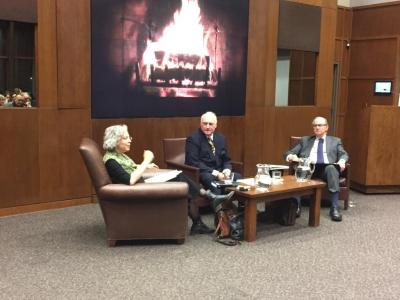Secondary menu
Breaking Legal Boundaries: Transnational Torts and Human Rights
Emma Julian, 3L

Both Justice Binnie and Mr. Fairley commended recent advances in Canadian law that permitted victims of human rights abuses committed on foreign territories to have their day in court in Canada. These legal developments are particularly important given that a significant number of global mining and exploration companies are headquartered in Canada. Often such companies operate in resource-rich countries where there are poor populaces, weak rule-of-law and inadequate human rights protections – a combination that can create fertile ground for corporate complicity in human rights violations.
Justice Binnie and Mr. Fairley identified several legal hurdles facing prospective plaintiffs in their pursuit of tort actions against Canadian corporations in Canada for acts committed abroad. Two of these were (1) to satisfy jurisdictional requirements and (2) to translate human rights obligations into domestic tort liability.
Satisfying jurisdictional requirements involves adapting traditional notions of jurisdiction. The doctrine allowing a domestic court to assume jurisdiction over a tort claim is outlined in Club Resorts Ltd v Van Breda, highlighting factors that connected a claim to the province. In Chevron, the SCC expanded this doctrine to allow a foreign judgment to be recognized and enforced in Canada as long as there was a real and substantial connection between the foreign court and the litigants or the subject matter of the dispute. The SCC found that a Canadian court would have jurisdiction to enforce the judgment of $9.51 billion USD awarded by the Ecuador Court of Cassation to 47 plaintiffs. They represented about 30,000 indigenous Ecuadorian villagers who sought redress for harms caused by Chevron’s oil exploration and extraction operations near their villages. As Chevron did not hold any assets in Ecuador, the plaintiffs sought enforcement of their judgment in Canada even though Chevron Canada was not directly involved in the harms committed.
Justice Gascon commented,“In today’s globalized world and electronic age, to require that a judgment creditor wait until the foreign debtor is present or has assets in the province before a court can find that it has jurisdiction in recognition and enforcement proceedings would be to turn a blind eye to current economic reality.” Justice Binnie agreed, commenting that for a court to decline jurisdiction on the basis of artificial corporate structures would be to ignore the real-life conditions under which large multi-national corporations operate.
A second hurdle is to translate human rights obligations into domestic tort liability. This involves a myriad of considerations that all point to the same question: are there existing domestic legal frameworks to support a finding of tort liability for human rights violations by corporations? The short answer put forward by Justice Binnie and Mr. Fairley was yes.
The first consideration is to what extent international law and international human rights norms are part of the law in Canada. Violations of international human rights treaties can and have become the basis for claims in tort in Canada. In Nevsun, the plaintiffs, local employees of the Canadian defendant’s mine in Eritrea, filed a civil claim alleging forced labour, slavery, torture and crimes against humanity. In Hudbay Minerals, the plaintiffs, indigenous Mayan Q’eqchi’ from Guatemala, alleged human rights abuses perpetrated by the Canadian defendant’s security personnel. In this case the Ontario Superior Court dismissed the defendant’s motion to strike because it was not plain and obvious that the plaintiffs’ claims failed to disclose a cause of action in negligence.
Canadian domestic law already has a strong framework for imposing liability on a corporation for the foreign tortious acts of its employees or contractors through enterprise liability. Justice Binnie emphasized that courts have been willing to hold organizations liable for the negligence of its employees or agents. The corporation’s employees are “legally synonymous” with the corporation itself, and this should not change just because the employees were acting on foreign territory.
Finally, Mr. Fairley noted that the conventional tort framework articulated in Cooper v Hobart is sufficient to establish liability for human rights abuses. He commented that a court can look at a corporation’s assumed obligations, such as those presented through public statements or in its corporate social responsibility policy, to determine whether it has assumed a duty of care it did not follow through with. For example, in Hudbay, the defendant made public statements that it was “dedicated to promoting and respecting human rights” and had implemented “internationally recognized Voluntary Principles on Security and Human Rights for [its] personnel and contractors in Guatemala.” The defendant’s security personnel were alleged to have committed gang rapes and murders of indigenous peoples. As Justice Binnie noted acerbically, “it always [looks] good in court to show that someone is a hypocrite.”
In general, both Justice Binnie and Mr. Fairley welcomed Canadian courts’ willingness to dismiss formalism in favour of an approach to adjudication that recognizes the realities of the 21st century. Of course, in addition to the above hurdles, there are further issues to consider, including the expense of litigating these claims; finding willing and capable plaintiffs; and determining the appropriate standard of proof for civil claims against what are ultimately criminal acts. Furthermore, Chevron, Hudbay and Nevsun have yet to be adjudicated on their respective merits. Nevertheless, these cases represent welcome developments in the law for the protection and enforcement of human rights.
Photo caption: Professor Audrey Macklin sits “fireside” with Mr. Scott Fairley (centre) and the Honourable Ian Binnie (right) at the International Human Rights Program’s (IHRP) “Transnational Torts in Canadian Courts” event on 19 January. (Photo credit: IHRP)
